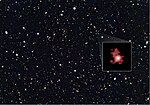astro.wikisort.org - Star
Kepler-737 is an M-type main-sequence red dwarf located 671 light-years away on the border of the constellation Cygnus. It was discovered by HARPS using the transit method and announced on May 10, 2016.[6]
 A transiting planet orbiting a star Kepler-737 | |
| Observation data Epoch J2000 Equinox J2000 | |
|---|---|
| Constellation | Cygnus[1] |
| Right ascension | 19h 27m 27.085s[2] |
| Declination | +46° 25′ 45.29″[2] |
| Characteristics | |
| Evolutionary stage | main-sequence[3] |
| Spectral type | M0V[3] |
| Apparent magnitude (G) | 15.127694[4] |
| Apparent magnitude (J) | 12.910[4] |
| Apparent magnitude (H) | 12.293[4] |
| Apparent magnitude (K) | 12.097[4] |
| Apparent magnitude (B) | 17.861[5] |
| Apparent magnitude (V) | 15.971[5] |
| Apparent magnitude (W) | 11.969[5] |
| Astrometry | |
| Proper motion (μ) | RA: 20.094[2] mas/yr Dec.: −19.889[2] mas/yr |
| Parallax (π) | 4.8590 ± 0.0194 mas[2] |
| Distance | 671 ± 3 ly (205.8 ± 0.8 pc) |
| Details | |
| Mass | 0.510+0.0026 −0.0027[1] M☉ |
| Radius | 0.480+0.0026 −0.0024[1] R☉ |
| Luminosity | ~0.045[5] L☉ |
| Surface gravity (log g) | 4.722±0.008[5] cgs |
| Temperature | 3,813+40.127 −38.492[3] K |
| Metallicity [Fe/H] | −0.24+0.087 −0.081[5] dex |
| Age | 3.89[5] Gyr |
| Other designations | |
| Database references | |
| SIMBAD | data |
Physical properties
General Properties
Kepler-737 is around half the size of the Sun, with a mass of 0.51 solar masses and a radius of 0.48 solar radii.[1] Its spectral class is M0V, its temperature is about 3,813 Kelvin, and it has a brightness of 0.045 solar luminosity.[5] One Kepler Object of Interest (KOI) table claimed the star to be ~14 billion years old.[5]
As for the logarithm of the relative abundance of iron and hydrogen, its metallicity [Fe/H] is −0.24+0.087
−0.081 dex, significantly lower than the Sun's. Its density is roughly 5.239±0.265 g/cm3.[5] Its gravity is weaker than the Sun, with log g of 4.722±0.008 cgs. Its stellar density is about ~5.239±0.265 g/cm3, while the sun is about 1.41 g/cm³.[5]
Astrometry and Characteristics
SIMBAD data indicate that its proper motion is 20.094 mas/yr for right ascension, −19.889 mas/yr for declination, its parallax is 4.859 mas.[4]
Planetary System
| Companion (in order from star) |
Mass | Semimajor axis (AU) |
Orbital period (days) |
Eccentricity | Inclination | Radius[6] |
|---|---|---|---|---|---|---|
| b | ~4.5 M🜨 | 0.035 | 28.592 | 0 | 89.99° | 1.96±0.11 R🜨 |
Kepler-737b
Kepler-737b[6] was discovered and suspected since May 18, 2016, for orbiting in the habitable zone but not likely to be inhabitable because Kepler-737b is tidally locked.[7] [8][9] Kepler-737b may instead have atmospheric circulation that would distribute the heat around the planet, potentially making a large portion of it habitable, although given its stellar flux the most likely scenario is that the planet's surface is too hot to be habitable. Water on Kepler-737b's surface could also distribute heat.
On the note of the Exoplanet Archive, Kepler-737b was dedicated that orbital period, transit mid-point, transit duration, Rp/Rs, and their errors are taken from DR24 KOI table[5]
References
- "Kepler-737". Universe Guide. Retrieved May 18, 2016.
- Brown, A. G. A.; et al. (Gaia collaboration) (2021). "Gaia Early Data Release 3: Summary of the contents and survey properties". Astronomy & Astrophysics. 649: A1. arXiv:2012.01533. Bibcode:2021A&A...649A...1G. doi:10.1051/0004-6361/202039657. S2CID 227254300. (Erratum: doi:10.1051/0004-6361/202039657e). Gaia EDR3 record for this source at VizieR.
- "Kepler-737". Exoplanet Kyoto. Retrieved May 18, 2016.
- "Kepler-737". SIMBAD. Retrieved May 18, 2016.
- "Kepler-737's Documentary in NASA Exoplanet Archive". NASA Exoplanet Archive. Retrieved May 18, 2016.
- "Planet beyond our solar system: Kepler-737b". Exoplanet Exploration. Retrieved May 18, 2016.
- "Tidally locked exoplanets may be more common than previously thought". UW News. Retrieved 2021-05-18.
- Hammond, Mark; Lewis, Neil T. (2021-03-30). "The rotational and divergent components of atmospheric circulation on tidally locked planets". Proceedings of the National Academy of Sciences. 118 (13): e2022705118. arXiv:2102.11760. Bibcode:2021PNAS..11822705H. doi:10.1073/pnas.2022705118. ISSN 0027-8424. PMC 8020661. PMID 33753500.
- Sutter, Paul (2021-03-08). "Can super-rotating oceans cool off extreme exoplanets?". Space.com. Retrieved 2021-05-18.
Другой контент может иметь иную лицензию. Перед использованием материалов сайта WikiSort.org внимательно изучите правила лицензирования конкретных элементов наполнения сайта.
WikiSort.org - проект по пересортировке и дополнению контента Википедии


